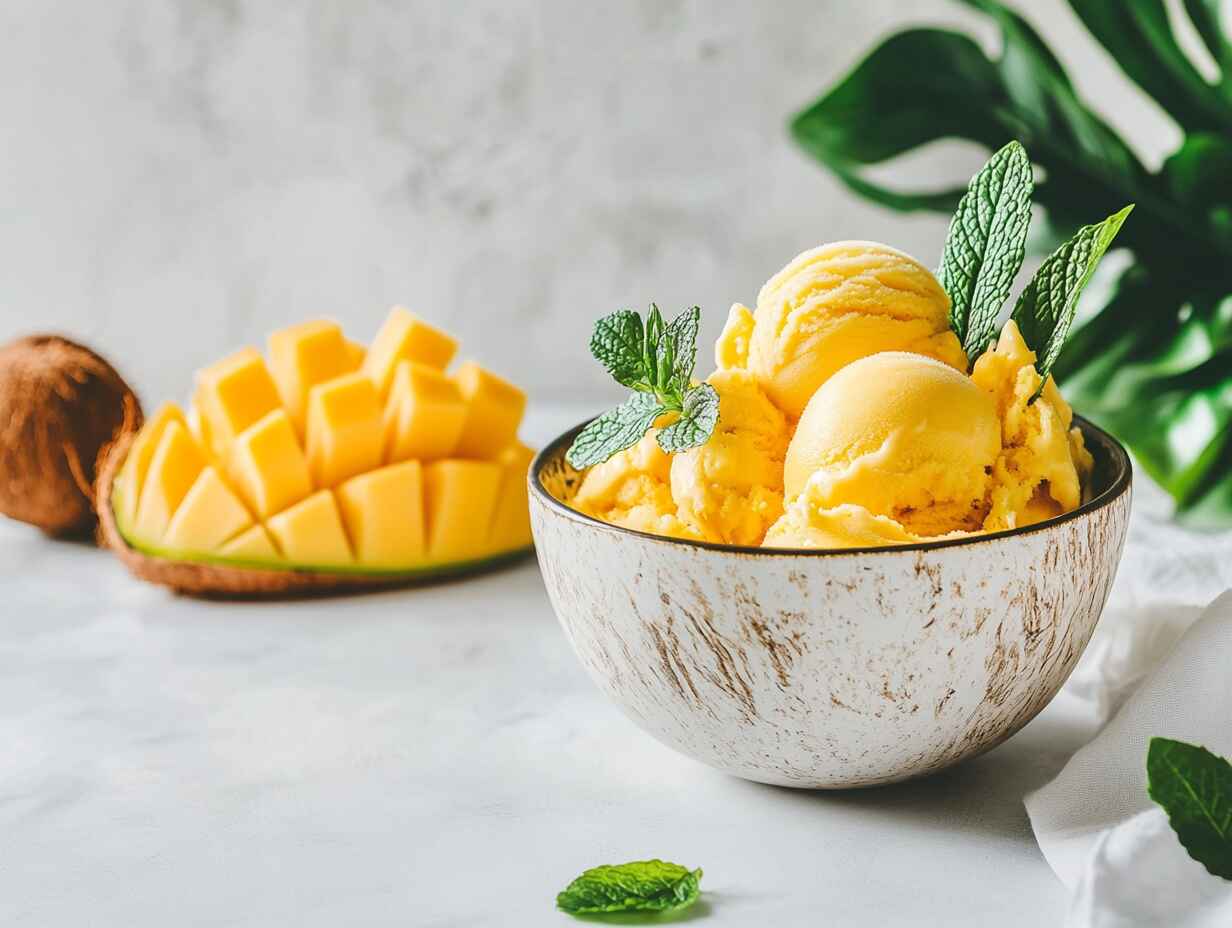Imagine this: it’s a warm, sunny afternoon, and you’re sitting on your porch, enjoying the gentle breeze. You take a spoonful of homemade mango ice cream, its sweetness and creaminess mingling in your mouth. The tropical flavors hit your taste buds just right, and for a moment, everything feels perfect. This isn’t just any ice cream, though. It’s Propitious Mango Ice Cream a treat that promises not only a burst of delicious mango flavor but also the kind of indulgence that makes every bite feel like a mini celebration.
Now, if you’re wondering, “What makes Propitious Mango Ice Cream different from the others?” well, you’re in for a treat! In this article, we’re going to walk you through the art of making this luxurious ice cream at home, from start to finish. You’ll learn about the key ingredients, easy-to-follow steps, and some pro tips to make sure your ice cream turns out perfectly every time. Check out our review of the best mango ice cream.
The Perfect Mango for Ice Cream Making
So, how do you choose the perfect mango for ice cream making? This is where the journey begins. Not all mangoes are created equal, and the right mango can make all the difference in your final product. Propitious mango ice cream relies on mangoes that are not only ripe but have the right texture, flavor, and sweetness. After all, the mango is the star of the show!
Choosing Ripe and Flavorful Mangoes
When you’re picking mangoes for ice cream, ripeness is key. An underripe mango will result in an ice cream that lacks the sweetness and vibrant flavor you’re looking for. Overripe mangoes, on the other hand, might give your ice cream a mushy, undesirable texture. So, what’s the secret to finding that perfect mango?
First, look for mangoes that have a slight give when you press gently on them. They should feel soft but not squishy. You’ll also want to check the skin color, which can vary depending on the variety of mango. For example, the Ataulfo mango (also known as the honey or champagne mango) has golden-yellow skin when ripe, while the Kent mango will show a deep red with green undertones. A ripe mango will also have a distinct, sweet smell near the stem. Want to know which is the best mango ice cream to try? Check out our review of the best mango ice cream.
Why Mango Variety Matters for Ice Cream
There are many varieties of mangoes, but not all of them are ideal for making ice cream. Some varieties are too fibrous, while others don’t have the deep, rich flavor needed for a truly propitious mango ice cream. Here’s a quick look at some of the most popular mango varieties and why they matter for your ice cream:
- Ataulfo Mango: Known for its creamy texture and sweet flavor, this small, yellow mango is perfect for ice cream because it blends smoothly.
- Kent Mango: With its slightly tangy and sweet taste, this variety is another great option for a balanced mango flavor.
- Haden Mango: A more fibrous mango, it’s best avoided for ice cream unless you’re looking to add a bit of texture.
Ultimately, the key to making propitious mango ice cream is selecting a variety that’s naturally sweet, rich in flavor, and has a smooth texture. The better the mango, the better your ice cream will be!
Key Ingredients for Making the Best Mango Ice Cream
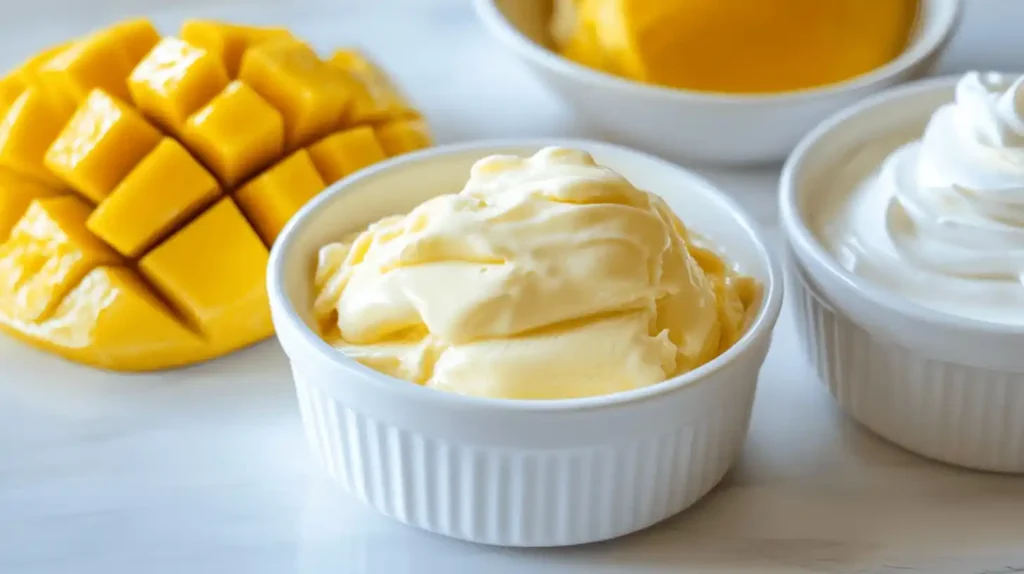
Fresh Mango: The Star of the Recipe
The most important ingredient in Propitious Mango Ice Cream is, of course, the mango! The fruit needs to be ripe and juicy for that perfect tropical flavor. When you go to the store, pick a mango that’s fragrant, slightly soft when you press it, and has a rich, golden color. This will ensure that the mangoes are sweet and full of flavor.
Sweetened Condensed Milk: Key to the Creaminess
Sweetened condensed milk is an absolute must in this recipe. It’s what gives Propitious Mango Ice Cream its smooth texture and rich sweetness. Unlike regular sugar, which can sometimes make ice cream icy, condensed milk keeps the mixture creamy. If you’re worried about the sweetness level, don’t be. It balances perfectly with the natural mango flavor.
Heavy Whipping Cream: Why It Matters
Heavy whipping cream is what turns the ice cream from a simple fruity treat into an indulgent dessert. The high-fat content in the cream contributes to that silky, smooth consistency. Without it, the ice cream could end up too thin or icy. This is the ingredient that gives Propitious Mango Ice Cream its luxurious texture, making each scoop feel like a little bite of heaven.
Optional: Coconut Oil and Chocolate Coating
While the classic Propitious Mango Ice Cream is perfect on its own, some people love adding a decadent touch with a coconut oil and chocolate coating. This step adds a layer of sweetness and a crunchy texture that pairs beautifully with the soft, creamy mango ice cream. It’s entirely optional, but it’s definitely worth trying if you want to make your mango ice cream extra special!
Curious about how to enhance mango flavor in ice cream? Check out our guide to enhancing mango flavor in ice cream.
Step-by-Step Process to Make Propitious Mango Ice Cream at Home
Now that we’ve covered the basics of mango selection and the ingredients, it’s time to get into the fun part making the ice cream! The process is relatively simple and can be done with just a few tools. Whether you’ve got an ice cream maker or you’re going the no-churn route, we’ve got you covered.
Preparing the Mango Puree
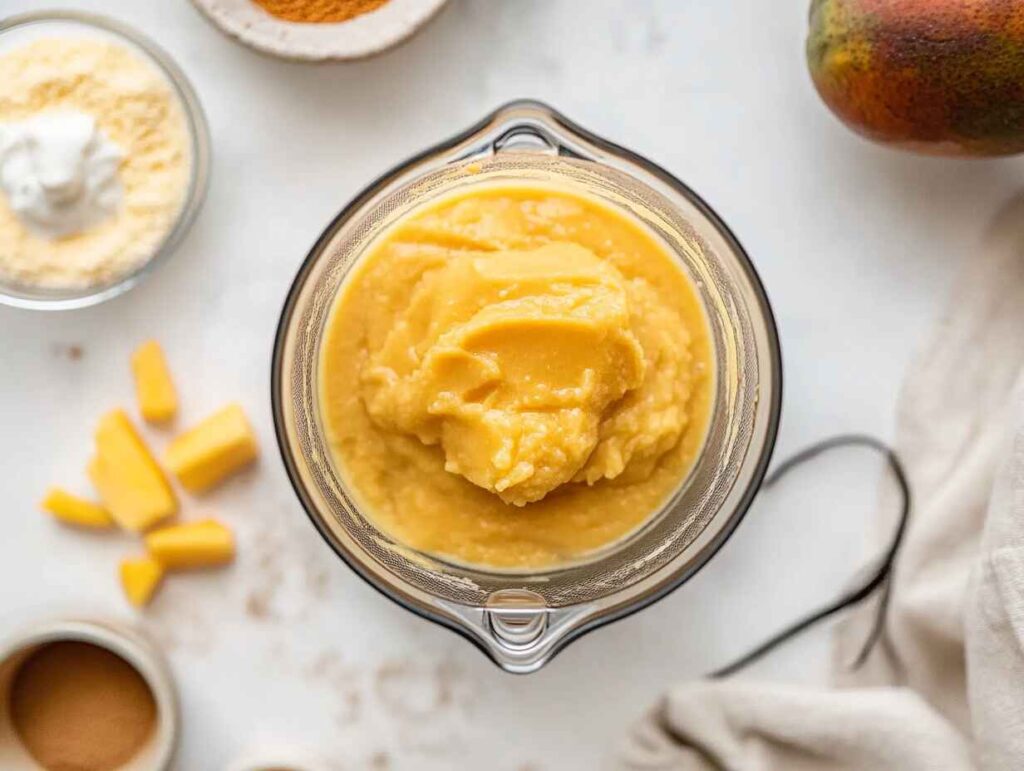
The first step in making Propitious Mango Ice Cream is preparing the mango puree. Start by peeling and chopping your mangoes. You’ll want to make sure they’re ripe so the flavor really shines through. Once you’ve chopped the mango into small pieces, place them in a blender or food processor and blend until smooth. If you like, you can add a little splash of lime juice to the puree to enhance the mango’s natural flavor, but this is optional.
Once blended, set the mango puree aside. You want it to be smooth and free of any chunks, so it mixes well with the cream later on.
Whipping the Cream for the Best Texture
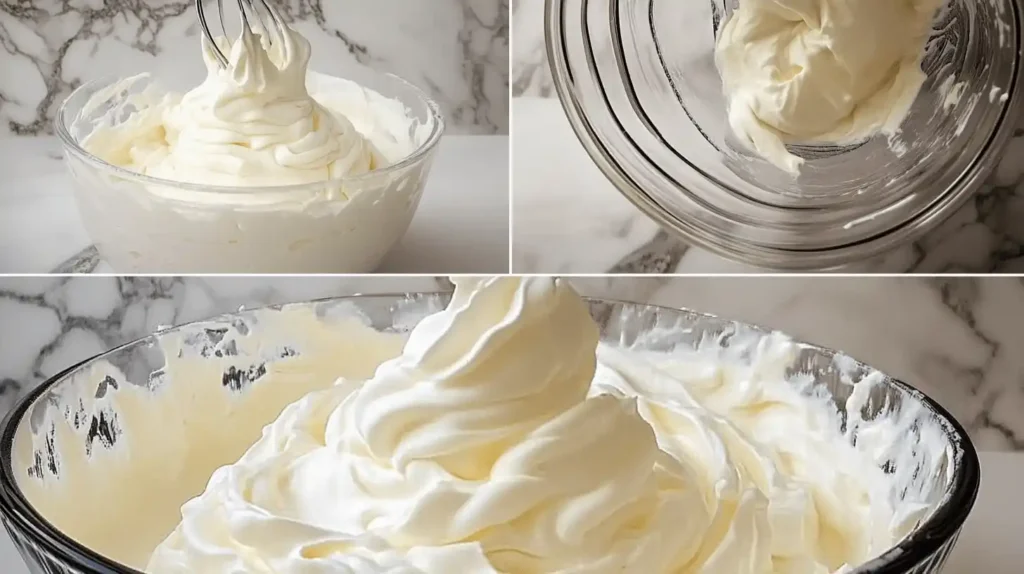
In a separate, chilled bowl, pour in the heavy whipping cream. Using an electric mixer, whip the cream until it forms stiff peaks. This means that when you lift the beaters out of the cream, the peaks will stand upright and not fold over. Be careful not to overwhip the cream, as this can cause it to turn into butter, which is not what we want here!
Whipping the cream is what gives the Propitious Mango Ice Cream its light, airy texture. This is a crucial step, so take your time and make sure the cream is well-whipped before moving on to the next step.
Combining Ingredients: The Secret to Smoothness
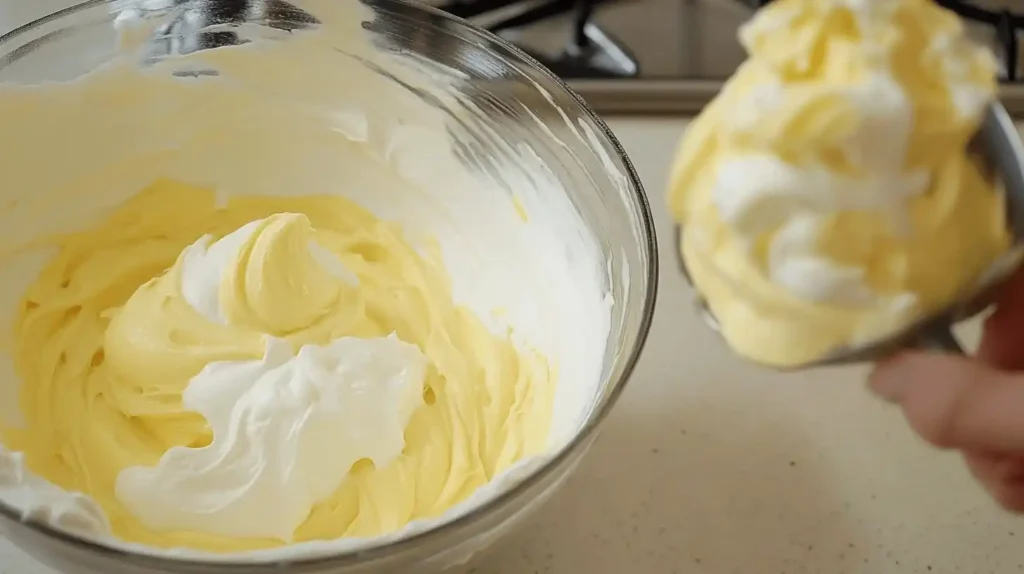
Once the cream is whipped to perfection, it’s time to add the sweetened condensed milk and the mango puree. Start by gently folding in the condensed milk with a spatula, making sure it’s evenly incorporated into the whipped cream. Next, fold in the mango puree. Take your time to mix everything together gently, ensuring that the mixture stays light and fluffy.
The key here is to combine the ingredients without deflating the whipped cream. This ensures that the Propitious Mango Ice Cream will be smooth, creamy, and light.
Freeze
Pour the mango mixture into silicone molds or any freezer-safe container. Insert popsicle sticks, if desired, and freeze for at least 6 hours until fully set.
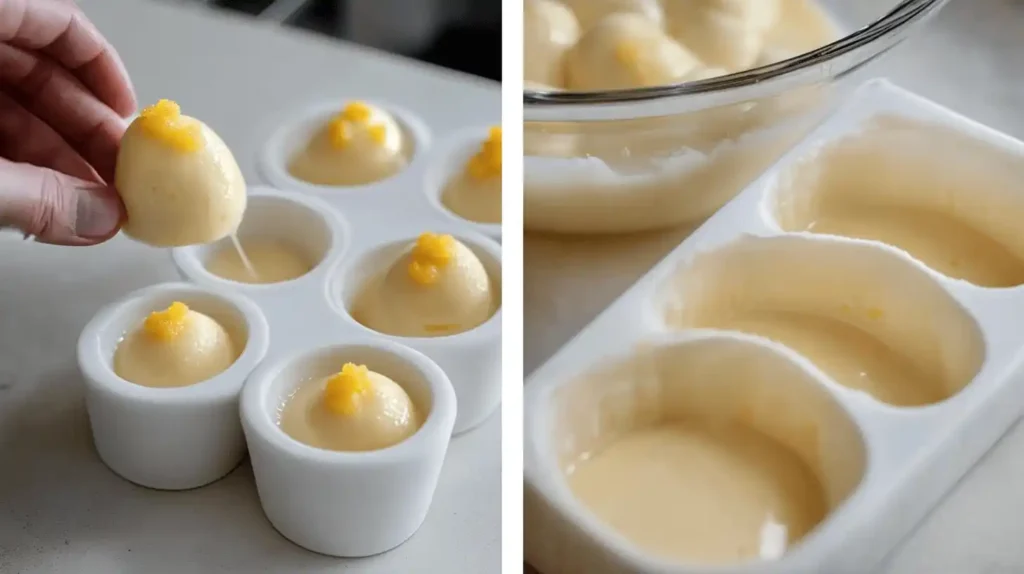
Chocolate Coating (Optional):
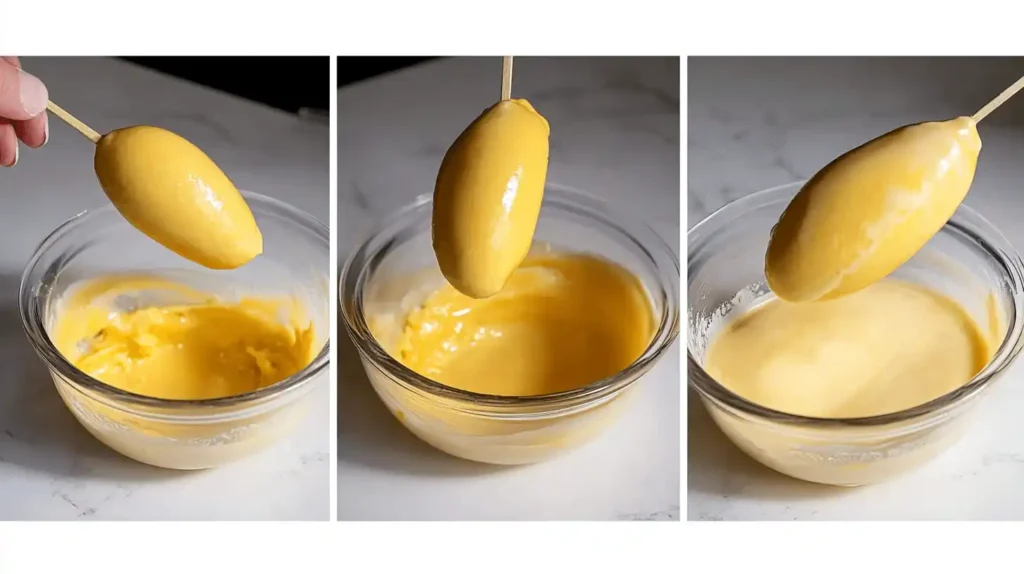
For an authentic mango look, melt yellow or white chocolate (adding coconut oil if needed for smoothness). Once the ice creams are frozen, dip each one into the melted chocolate and return to the freezer for 30 minutes.
Serve:
Once the coating is set, serve your homemade Propitious Mango Ice Cream and enjoy this delightful treat!
Delicious Mango Ice Cream Variations and Add-ins
One of the best parts about making mango ice cream is that it’s so versatile! You don’t have to stop at just mango you can mix in a variety of ingredients to create a custom ice cream flavor. Whether you want a tropical twist or a spiced-up version, there are endless possibilities to explore. Here are a few fun add-ins and variations that can elevate your mango ice cream!
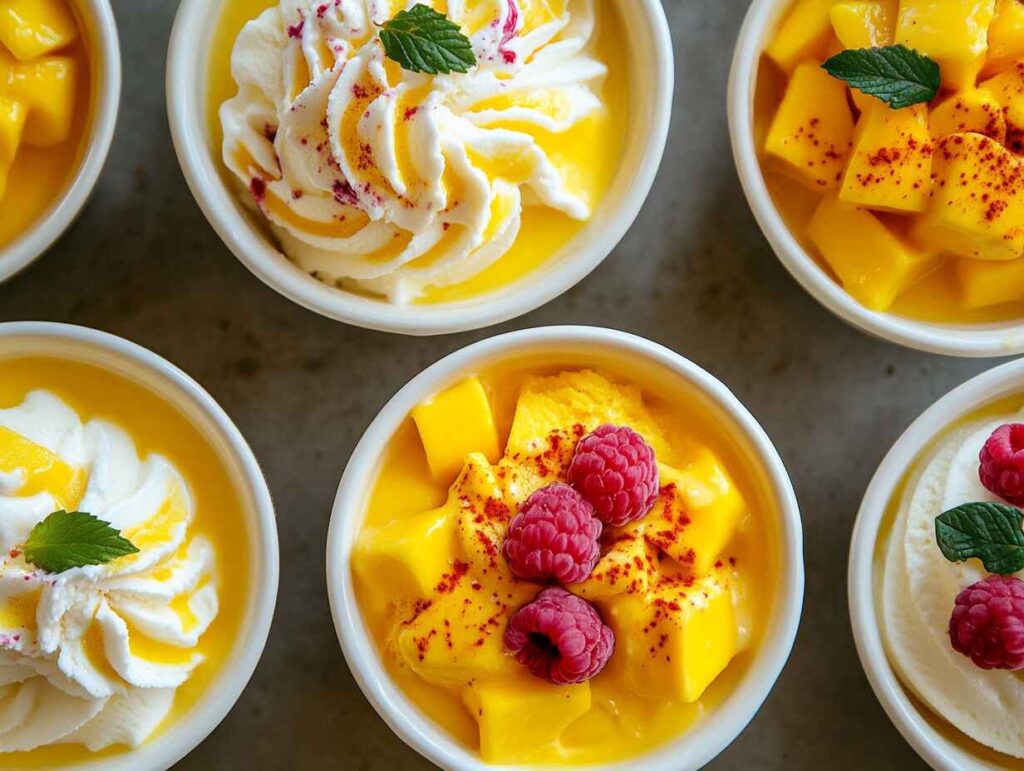
Tropical Twist: Adding Coconut, Pineapple, or Lime
If you want to give your mango ice cream a more tropical vibe, try adding coconut, pineapple, or lime. These ingredients enhance the flavor and create a fun, refreshing combination that transports you straight to a beachside paradise!
- Coconut: Add shredded coconut or coconut milk to your mango ice cream for an extra creamy texture and a subtle coconut flavor.
- Pineapple: Fresh or frozen pineapple can complement the mango’s sweetness and add a bit of tartness to balance the flavor. You can even swirl some pineapple puree through the ice cream for a swirl effect.
- Lime: A splash of fresh lime juice or zest will brighten the flavor and bring out the mango’s natural citrus notes. Lime pairs so well with mango, creating an irresistible tropical flavor profile.
These ingredients will transport your mango ice cream to another level, making it feel like a tropical treat you’ll want to enjoy all summer long.
Spice It Up: Ginger, Chili, and Other Creative Flavors
If you’re a fan of bold flavors, why not spice things up? Mango ice cream has a natural sweetness that pairs beautifully with a touch of heat or spice. Here are some creative add-ins to consider:
- Ginger: Fresh ginger adds a zesty kick to your mango ice cream. The spiciness of the ginger complements the smooth sweetness of the mango for a perfectly balanced dessert.
- Chili: If you like a little heat, try adding chili powder or cayenne pepper. The combination of mango and chili is common in many cultures and creates a surprising, mouthwatering contrast.
- Cinnamon or Cardamom: These spices can add warmth and depth to your mango ice cream. A pinch of cinnamon or cardamom will give your dessert a cozy, exotic flavor.
These spices and add-ins are sure to create a unique flavor profile that will stand out from the crowd and impress your friends and family. Dive into our exploration of mango ice cream flavor combinations.
Storing and Serving Your Mango Ice Cream
Once you’ve made your delicious propitious mango ice cream, it’s time to store and serve it! Proper storage and creative serving ideas will ensure that your ice cream stays fresh and looks amazing when served.
How to Store Mango Ice Cream for Long-Lasting Freshness
To keep your mango ice cream fresh and creamy, make sure it’s stored properly. The best way to store ice cream is in an airtight container. This will help prevent ice crystals from forming and keep the texture smooth. If you’ve made a large batch, you can divide it into smaller containers for easy access and to reduce the amount of time the ice cream is exposed to air when opening the container.
Make sure to cover the surface of the ice cream with a piece of wax paper or plastic wrap before sealing the container. This will help prevent ice from forming on top and keep the texture intact. If you’re planning to store it for a long period, it’s a good idea to label the container with the date so you know how long it’s been in the freezer. Mango ice cream is best enjoyed within a few weeks for the freshest taste.
Creative Serving Ideas: Waffle Cones, Sundaes, and More
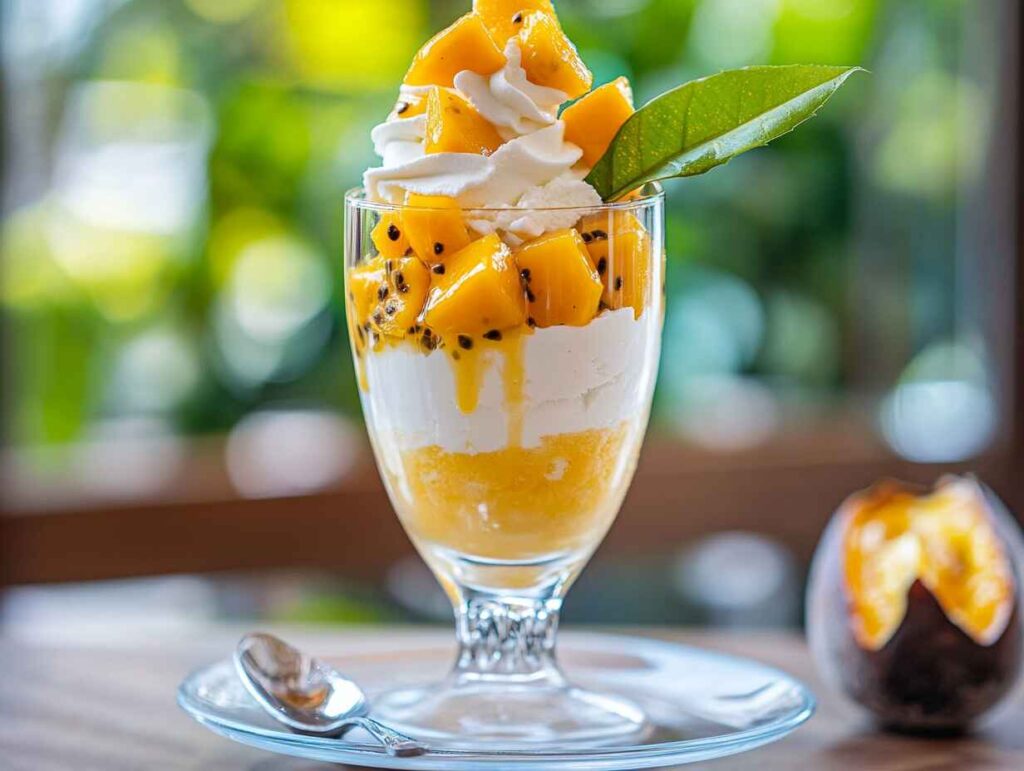
Now comes the fun part – serving your ice cream! While a simple scoop in a bowl is always delicious, there are plenty of creative ways to serve your mango ice cream that will wow your guests. Here are a few ideas:
- Waffle Cones: A classic! Serve your mango ice cream in a crispy waffle cone for the perfect crunchy contrast.
- Ice Cream Sundaes: Top your mango ice cream with fresh fruit, toasted coconut, or a drizzle of caramel sauce for a luxurious sundae.
- Fruit Bowls: For a light and refreshing treat, serve your mango ice cream in a bowl with fresh tropical fruits like papaya, kiwi, and dragon fruit.
- Sandwiches: Try making ice cream sandwiches by placing a scoop of mango ice cream between two cookies or soft waffles.
Get creative with how you serve your mango ice cream, and have fun experimenting with toppings and combinations!
Frequently Asked Questions about Mango Ice Cream
Can I Use Frozen Mangoes?
Yes, frozen mangoes can work well for making mango ice cream, especially if fresh mangoes aren’t in season. However, make sure the frozen mangoes are thawed slightly before blending to get a smoother texture. Using fresh mangoes, though, will usually give you a more vibrant flavor.
How Can I Make Mango Ice Cream Without an Ice Cream Maker?
If you don’t have an ice cream maker, no problem! Just follow the same process, but instead of churning, pour the mixture into a shallow dish and freeze it. Stir it every 30 minutes to break up the ice crystals until you get the creamy texture you want. It might take a little longer, but you’ll still end up with delici
Conclusion
Mango ice cream is more than just a dessert it’s a celebration of tropical flavors, creamy textures, and the joy of creating something special at home. Whether you’re using ripe Alphonso mangoes, experimenting with unique add-ins, or trying out a vegan twist, the possibilities with mango ice cream are endless.
This guide has equipped you with everything from selecting the best mangoes and tools to mastering the art of creamy texture and experimenting with global variations. With a little practice and creativity, you’ll be making mango ice cream that rivals the best gourmet parlors.
So, why wait? Gather your ingredients, follow the steps, and treat yourself to a scoop (or two!) of propitious mango ice cream. Your taste buds will thank you.
Print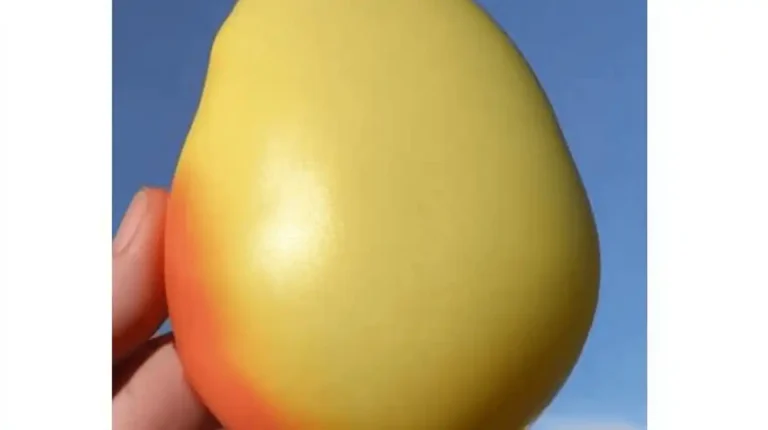
How to Make Propitious Mango Ice Cream: A Step-by-Step Guide
A creamy, tropical mango ice cream that’s easy to make and bursting with fresh mango flavor. Perfect for hot summer days or as a delightful treat any time of the year!
- Total Time: 4 hours 10 minutes
- Yield: 6 servings
Ingredients
- 1 ripe mango (peeled and chopped)
- 1 cup heavy whipping cream
- 1/2 cup sweetened condensed milk
- 1 tbsp coconut oil (optional, for smooth chocolate coating)
- 1/2 cup yellow or white chocolate (for coating, optional)
Instructions
Prepare Mango Puree: Peel and chop the mango, then blend it until smooth to make a rich, creamy mango puree.
Whip the Cream: In a chilled bowl, whip the heavy cream until stiff peaks form. This will provide the base for the creamy texture of the ice cream.
Combine with Condensed Milk: Add the sweetened condensed milk to the whipped cream and mix gently until fully incorporated.
Mix Mango Puree: Fold in the mango puree with a low-speed mixer until the mixture is smooth and evenly blended.
Freeze: Pour the mango mixture into silicone molds or any freezer-safe container. Insert popsicle sticks, if desired, and freeze for at least 6 hours until fully set.
Chocolate Coating (Optional): For an authentic mango look, melt yellow or white chocolate (adding coconut oil if needed for smoothness). Once the ice creams are frozen, dip each one into the melted chocolate and return to the freezer for 30 minutes.
Serve: Once the coating is set, serve your homemade Propitious Mango Ice Cream and enjoy this delightful treat!
Notes
- If you don’t have an ice cream maker, pour the mixture into a container and freeze, stirring every 30 minutes for about 3 hours to break up ice crystals.
- For a richer taste, replace some of the milk with coconut milk.
- Add mix-ins like chopped mango pieces, toasted coconut, or white chocolate chips for extra texture.
- Prep Time: 10 minutes
- Cook Time: 0 minutes
- Category: Dessert
- Method: Churned
- Cuisine: Tropical, Fusion
- Diet: Vegetarian

